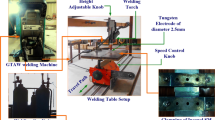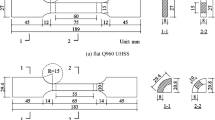Abstract
Thick plate bending process (warm bending and tempering) has a profound impact on the material strength distribution (MSD) in hydrogenation reactor shells. To date, few studies have studied the thick plate bending process. In this work, an artificial neural network (ANN) combined with finite element analysis (FEA) was utilized to investigate the impact of thick plate bending on the MSD of reactor shells. First, tensile tests of 0-10% pre-strained 2.25Cr-1Mo-0.25 V specimens were subjected to 390 to 510 °C. The results obtained from this experiment were used to develop ANN with two inputs (temperature and plastic strain) to predict the strength of pre-deformed steel. Subsequently, the plastic strain distribution of reactor shells after warm bending was obtained via FEA. We then inputted the FEA results into well-established ANN to predict the MSD of un-tempered reactor shells. The MSD of an actual tempered reactor shell was measured to study the synergic effect of warm bending and tempering on MSD variation. Results showed that the average absolute relative errors between the proposed ANN and tensile test results were below 4%. The absolute relative errors of the proposed prediction method varied from 0.24 to 7.88%. The proposed method is therefore reliable in the lightweight design of the hydrogenation reactor.























Similar content being viewed by others
References
D. Wang, Y. Li, L. Jin, K. Hao, B. Wei, D. Yao, and H. Haoquan, Integrated process for partial oxidation of heavy oil and in situ reduction of red mud, Appl. Catal. B, 2019, 258(10), p 968–973 (in English)
G.H.C. Prado, Y. Rao, and A. de Klerk, Nitrogen removal from oil: a review, Energy Fuels, 2017, 31(1), p 14–36 (in English)
Y. Zhang, L. Huang, X. Xi, W. Li, G. Sun, S. Gao, and S. Zhang, Deep conversion of venezuela heavy oil via integrated cracking and coke gasification − combustion process, Energy Fuels, 2017, 31(9), p 9915–9922 (in English)
Y. Zhang, Y. Deping, W. Li, Y. Wang, S. Gao, and X. Guangwen, Fundamentals of petroleum residue cracking gasification for coproduction of oil and syngas, Ind. Eng. Chem. Res., 2012, 51(46), p 15032–15040 (in English)
S. Huang, Z. Chen, Y. Li, and D. Zhang, Impact of hot bending forming on the high temperature mechanical properties and hydrogen damage of 2.25Cr-1Mo-0.25 V steel, J. Mater. Eng. Perform., 2019, 28(1), p 567–577 (in English)
H. Zhou, X. Chi, Q. Wang, H. Pan, and J. Chen, Characterization of hydrogen embrittlement by eddy current method, Res. Nondestr. Eval., 2018, 29(4), p 212–220 (in English)
Y. Liu and Q. Pang, Study on endurance property of 2.25Cr-1Mo-0.25 V steel hydrogenation cylinder forgings, Hot Work Technol., 2018, 47(1), p 158–160 (164, in Chinese)
Y. Wang, G. Cheng, M. Qin, Q. Li, Z. Zhang, K. Chen, Y. Li, H. Hu, W. Wu, and J. Zhang, Effect of high temperature deformation on the microstructure, mechanical properties and hydrogen embrittlement of 2.25Cr-1Mo-0.25 V steel, Int. J. Hydrog. Energy, 2017, 42(38), p 24549–24559 (in English)
Y. Song, M. Chai, B. Yang, Z. Han, S. Ai, Y. Liu, G. Cheng, and Y. Li, Investigation of the influence of pre-charged hydrogen on fracture toughness of as-received 2.25Cr1Mo0.25 V steel and weld, Materials, 2018, 11(7), p 1068 (in English)
Y. Song, M. Chai, B. Yang, Z. Han, S. Ai, Y. Liu, G. Cheng, and Y. Li, Effect of cementite on the hydrogen diffusion/trap characteristics of 2.25Cr-1Mo-0.25 V steel with and without annealing, Materials, 2018, 11(5), p 788 (in English)
Y. Song, M. Chai, W. Wu, Y. Liu, M. Qin, and G. Cheng, Experimental investigation of the effect of hydrogen on fracture toughness of 2.25Cr-1Mo-0.25 V steel and welds after annealing, Materials, 2018, 11(4), p 499 (in English)
Z. Jiang, P. Wang, D. Li, and Y. Li, The evolutions of microstructure and mechanical properties of 2.25Cr-1Mo-0.25 V steel with different initial microstructures during tempering, Mater. Sci. Eng. A-Struct. Mater. Properties Microstruct. Process., 2017, 699, p 165–175 (in English)
Z. Jiang, P. Wang, D. Li, and Y. Li, Effects of tempering temperature on the microstructure and mechanical properties of granular bainite in 2.25Cr-1Mo-0.25 V steel, Acta Metall. Sin., 2015, 51(8), p 925–934 (in Chinese)
R.D. Fu, S.F. Wu, W.H. Zhou, W.H. Zhang, Y.Q. Yang, and F.C. Zhang, Effects of heat treatment processes on microstructure and properties of 2·25Cr–1Mo–0·25 V HSLA steels, Metal Sci. J., 2013, 25(1), p 50–55 (in English)
Z. Hua, X. Zhang, J. Zheng, C. Gu, T. Cui, Y. Zhao, and W. Peng, Hydrogen-enhanced fatigue life analysis of Cr–Mo steel high-pressure vessels, Int. J. Hydrog. Energy, 2017, 42(16), p 12005–12014 (in English)
C. Wu, B. Jia, and S. Han, Coupling a cellular automaton model with a finite element model for simulating deformation and recrystallization of a low-carbon micro-alloyed steel during hot compression, J. Mater. Eng. Perform., 2019, 28(2), p 938–955 (in English)
C. Liu and J. Gao, Stress corrosion of hydrogenation reactor material, J. Northeast For. Univ., 2009, 37(4), p 65–57 (in Chinese)
O. Sabokpa, A. Zarei-Hanzaki, H.R. Abedi, and N. Haghdadi, Artificial neural network modeling to predict the high temperature flow behavior of an AZ81 magnesium alloy, Mater. Des., 2012, 39, p 390–396 (in English)
H. Ahmed, M.A. Wells, D.M. Maijer, B.J. Howes, and M.R. van der Winden, Modelling of microstructure evolution during hot rolling of AA5083 using an internal state variable approach integrated into an FE model, Mater. Sci. Eng., A, 2005, 390, p 278–290 (in English)
S.B. Davenport, N.J. Silk, C.N. Sparks, and C.M. Sellars, Development of constitutive equations for modelling of hot rolling, Mater. Sci. Technol., 2000, 16, p 539–546 (in English)
J. Luo, M. Li, X. Li, and Y. Shi, Constitutive model for high temperature deformation of titanium alloys using internal state variables, Mech. Mater., 2010, 42, p 157–165 (in English)
Y. Xia, W. Jiang, Q. Cheng, L. Jiang, and L. Jin, Hot deformation behavior of Ti-6Al-4 V-0.1Ru alloy during isothermal compression, Trans. Nonferrous Metals Soc. China, 2020, 30(1), p 134–146
Y. Han, G. Qiao, J. Sun, and D. Zou, A comparative study on constitutive relationship of as-cast 904L austenitic stainless steel during hot deformation based on Arrhenius-type and artificial neural network models, Comput. Mater. Sci., 2013, 67, p 93–103 (in English)
Z. Sun, H. Yang, and Z. Tang, Microstructural evolution model of TA15 titanium alloy based on BP neural network method and application in isothermal deformation, Comput. Mater. Sci., 2010, 50(2), p 308–318 (in English)
G. Quan, W. Lv, Y. Mao, Y. Zhang, and J. Zhou, Prediction of flow stress in a wide temperature range involving phase transformation for as-cast Ti–6Al–2Zr–1Mo–1 V alloy by artificial neural network, Mater. Des., 2013, 50, p 51–61 (in English)
Y. Zhu, W. Zeng, Y. Sun, F. Feng, and Y. Zhou, Artificial neural network approach to predict the flow stress in the isothermal compression of as-cast TC21 titanium alloy, Comput. Mater. Sci., 2011, 50, p 1785–1790 (in English)
Z. Cai, H. Ji, W. Pei, X. Tang, L. Xin, L. Yonghao, and W. Li, An investigation into the dynamic recrystallization (DRX) behavior and processing map of 33Cr23Ni8Mn3N based on an artificial neural network (ANN), Materials, 2020, 13(6), p 1282 (in English)
X. Wu, H. Zhang, H. Cui, Z. Ma, W. Song, W. Yang, L. Jia, and H. Zhang, Quantitative relationship analysis of mechanical properties with mg content and heat treatment parameters in Al–7Si alloys using artificial neural network, Materials, 2019, 12(5), p 718 (in English)
Y. Zhou, Y. Xia, L. Jiang, S. Long, and D. Yang, Modeling of the hot flow behaviors for Ti-6Al-4 V-0.1Ru alloy by GA-BPNN model and its application, High Temp. Mater. Process (London), 2018, 37(6), p 551–562 (in English)
G. Quan, J. Pan, and X. Wang, Prediction of the hot compressive deformation behavior for superalloy nimonic 80A by BP-ANN model, Appl. Sci, 2016, 6(3), p 66 (in English)
Metallic materials-tensile testing-part 2: method of test at elevated temperature, GB/T 228.2, Chinese Standard, 2015
P. Tao, C. Zhang, and Z. Yang, Evolution of second phase in 2.25Cr-1Mo-0.25 V steel weld metal during high temperature tempering, Acta Metall. Sin., 2009, 45(1), p 51–57 (in Chinese)
H. White, Learning in artificial neural networks: a statistical perspective, Neural Comput., 2014, 1(4), p 425–464 (in English)
S. Dreiseitla and L. Ohno-Machadob, Logistic regression and artificial neural network classification models: a methodology review, J. Biomed. Inform., 2002, 35(5–6), p 352–359 (in English)
Y. Gao, Fabrication of plate-welding type hydro-reactor made of 2.25Cr-1Mo-0.25 V steel, Press. Vessel Technol., 2006, 23(12), p 33–36 (in Chinese)
Q. Yue, Analysis for the plate bending process of the four-roll plate bending machine, Lanzhou Jiaotong University, 2014, in Chinese
A. Ktari, Z. Antar, N. Haddar, and K. Elleuch, Modeling and computation of the three-roller bending process of steel sheets, J. Mech. Sci. Technol., 2012, 26(1), p 123–128 (in English)
X. Han and L. Hua, 3D FE modeling of cold rotary forging of a ring workpiece, J. Mater. Process. Technol., 2009, 209(1–2), p 5353–5362 (in English)
G.Y. Zhao, Y.L. Liu, H. Yang, C.H. Lu, and R.J. Gu, Three-dimensional finite-elements modeling and simulation of rotary-draw bending process for thin-walled rectangular tube, Mater. Sci. Eng. A-Struct. Mater. Prop. Microstruct. Process., 2009, 499(1–2), p 257–261 (in English)
S. Huang, Z. Chen, Y. Li, and D. Zhang, Effect of warm forming on microstructure and mechanical properties of 2.25Cr1Mo0.25 V steel cylindrical shell, Heat Treat. Met., 2019, 44(5), p 77–82 (in Chinese)
Z. Liu, C. Liu, L. Miao, X. Guo, J. Ding, and H. Zhang, The evolution of complex carbide precipitates in a low alloy Cr-Mo-V steel after long-term aging treatment, Materials, 2019, 12(10), p 1724 (in English)
R.D. Fu, Y.Q. Yang, C.Y. Wang, and W.H. Zhang, Effects of weld thermal cycles and post-welding tempering on second phase particles in 2·25Cr–1Mo–0·25 V steels, Sci. Technol. Weld. Joining, 2008, 13(4), p 349–356 (in English)
L. Song, R. Sun, W. Gu, and X. Li, Effects of heat treatment process on microstructure and mechanical properties of 2.25Cr-1Mo-0.25 V steel weld seam, Heat Treat. Met., 2015, 40(12), p 110–113 (in Chinese)
D. Wu, F. Wang, C. Jin, and C. Li, Effects of Nb and tempering time on carbide precipitation behavior and mechanical properties of Cr-Mo-V steel for brake discs, Steel Res. Int., 2018, 89(5), p 1700491 (in English)
X. Liu, S. Nie, and Y. ren, Effects of predeformation diffusion annealing on distribution of alloy agents and structures, J. Plast. Eng., 2007, 14(6), p 138–141 (in English)
J. Zhang, W. Zhang, F. Ruidong, and C. Wang, Hot deforming behaviors and microstructures of 2.25Cr-1Mo-0.25 V steels, J. Plast. Eng., 2010, 17(3), p 44–49 (in Chinese)
D. Sylvain, T.M. Caroline, U. Stephane, R. Justine, M. Bernard, R. Francois, K. Ernst, G. Lorenzon, and A. Francoise, Carbide precipitation in 2.25Cr-1Mo bainitic steel: effect of heating and isothermal tempering conditions, Metall. Mater. Trans. A-Phys. Metallurgy Mater. Sci., 2017, 48A(5), p 2164–2178 (in English)
M. Qin, G. Cheng, Z. Zhang, Q. Li, J. Zhang, Numerical simulation of temperature field and residual stress in multi-pass welds in 2.25Cr-1Mo-0.25 V steel plate and comparison with experimental measurements, in Proceedings of the Asme Pressure Vessels And Piping Conference, Waikoloa, HI, Jul 2017
P. Tao, C. Zhang, Z. Yang, and H. Takeda, Evolution and coarsening of carbides in 2.25Cr-1Mo steel weld metal during high temperature tempering, J. Iron Steel Res., 2010, 17(5), p 74–78 (in English)
Acknowledgments
This work was supported by National Key Basic Research and Development Project of China (973 Project No. 2015CB057603) and National Natural Science Foundation of China (Grant No. 51905173).
Author information
Authors and Affiliations
Corresponding author
Additional information
Publisher's Note
Springer Nature remains neutral with regard to jurisdictional claims in published maps and institutional affiliations.
Rights and permissions
About this article
Cite this article
Li, Y., Chen, Z., Jiao, P. et al. Influence of Thick Plate Bending Process on Material Strength Distribution in Hydrogenation Reactor Shells. J. of Materi Eng and Perform 29, 5158–5173 (2020). https://doi.org/10.1007/s11665-020-05020-4
Received:
Revised:
Published:
Issue Date:
DOI: https://doi.org/10.1007/s11665-020-05020-4




